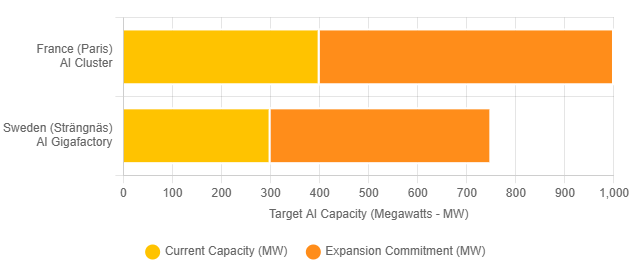Is Brookfield’s $100B AI Bet the Beginning of a New Sovereign Compute Race in Europe?
Brookfield’s $100B AI Push Sparks Europe’s Race for Sovereign Compute
Welcome to Global Data Center Hub. Join investors, operators, and innovators reading to stay ahead of the latest trends in the data center sector in developed and emerging markets globally.
Europe is entering a new era where compute, not manufacturing or telecom, defines national power.
Brookfield’s $100 billion AI infrastructure program signals a shift from cloud dependency to compute sovereignty. What appears as a private-equity initiative is really the opening move in a race to secure domestic AI capacity before geopolitical and energy constraints tighten.
This explains why Brookfield chose Europe, why sovereign AI is the new battleground, and how this platform could determine which nations lead or lag in the AI era.
Europe’s Turning Point: AI as Critical Infrastructure
Europe has long lagged behind the US and Asia in cloud scale, GPU density, and hyperscale deployment.
The political mindset is changing. Regulators now treat AI compute as critical infrastructure, on par with energy grids and national security.
Policymakers agree: high-density compute is vital, energy (not land or capital) is the main constraint, and nations need sovereign control over AI models, data, and compute.
This shift has made Europe the focus of Brookfield’s first major sovereign AI programs, aligned with the region’s drive for guaranteed, power-stable domestic compute.
Why Brookfield Chose Europe First
Brookfield’s expertise in renewables, digital infrastructure, and utilities makes Europe an ideal focus, with strong momentum toward sovereign AI and favorable regulations.
Europe’s fragmented digital landscape dominated by local operators and aging facilities creates an opening for a fully integrated player controlling land, power, permitting, construction, and compute.
Brookfield is stepping in as an industrial partner, not a traditional developer, capable of delivering national-scale AI capacity faster than legacy operators.
France: The First Sovereign Compute Megaproject
France exemplifies Brookfield’s strategy, with a multi-billion-dollar plan to triple AI-ready data center capacity, led by the Data4 platform.
In Paris, the goal is Europe’s largest AI cluster (1GW+) a foundation for Western Europe’s first AI-native industrial zone.
Aligned with NVIDIA’s DSX designs and backed by sovereign partnerships, the project ensures long-term, high-density compute.
France cannot lead in defense AI, biotech, aerospace, or automation without domestic capacity, and Brookfield delivers the predictable, sovereign-aligned infrastructure it needs.
Sweden: Europe’s First AI Gigafactory Blueprint
If France showcases brownfield expansion, Sweden represents greenfield AI industrialization. Brookfield’s Strängnäs program aims to expand capacity from 300MW to 750MW, one of Europe’s first large-scale AI factories.
Sweden’s cold climate, stable grid, efficient permitting, and renewable energy mix make it ideal for national AI infrastructure.
Brookfield is building more than data centers. It is creating a replicable AI factory blueprint for Europe.
The site includes liquid-cooled GPU halls, dense power distribution, long-duration renewable contracts, and integration with NVIDIA designs. If France is the AI headquarters, Sweden is the manufacturing floor.
The Power Shift: Why AI Factories Require Sovereign Solutions
Europe’s power crisis has become the main bottleneck for AI investment. Existing grids were not built to handle gigawatt-scale AI clusters, and utilities cannot absorb multi-year GPU-driven demand surges.
Brookfield’s $5 billion partnership with Bloom Energy tackles this by providing behind-the-meter baseload power, bypassing interconnection queues. Fuel-cell onsite power is the only near-term way to activate gigawatt-scale AI campuses without waiting for new transmission lines.
For sovereigns, this is transformative. It allows nations to deploy AI capacity on their own timelines rather than utility schedules.
The result is a new competitive frontier: the country that secures power-stable compute fastest will lead Europe’s AI race.
Europe’s Emerging Sovereign Compute Race
Brookfield’s program has brought Europe to a turning point. The focus is no longer whether domestic AI infrastructure is needed, but which country builds it first, at what scale, and under what governance.
Sovereigns now demand domestic clusters governed by national law. Nations with surplus renewable energy Sweden, Norway, Finland, and parts of France will lead early deployments, making geography a key factor.
Infrastructure managers with integrated power portfolios will hold the advantage, able to deploy AI clusters in 18–24 months, instead of years.
Brookfield’s timing is deliberate, positioning the firm at the forefront of Europe’s emerging industrial competition.
What This Means for Europe’s Next Decade
Sovereign compute is set to reshape Europe’s political economy. Nations will compete on GPU density, onsite power stability, permitting speed, land assembly, and grid-bypass capabilities not cloud region count or electricity pricing.
The European Commission is signaling support for national AI corridors. France aims to be the hub for AI model training, Sweden the manufacturing center, while Germany, Spain, and Italy pursue multi-hundred-megawatt deployments.
Brookfield’s initiative is more than a capital program; it serves as a template for governments, utilities, and infrastructure operators across Europe.
The era of treating data centers as mere real estate is over. Europe has entered the era of sovereign compute.
Strategic Takeaways
Brookfield’s $100 billion AI program sets the scale for sovereign AI in Europe, integrating power, land, permitting, and GPU-dense infrastructure at national scale.
France represents the AI headquarters with brownfield expansion, while Sweden provides the greenfield AI factory blueprint, establishing operational and geographic benchmarks.
Power stability is the decisive constraint, and Europe’s competitiveness will now hinge on GPU density, energy self-sufficiency, permitting speed, and grid-bypass capabilities.


